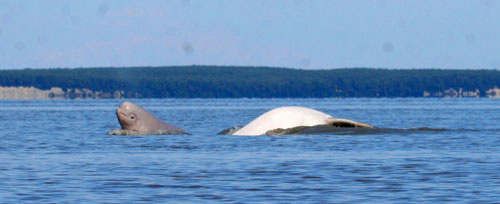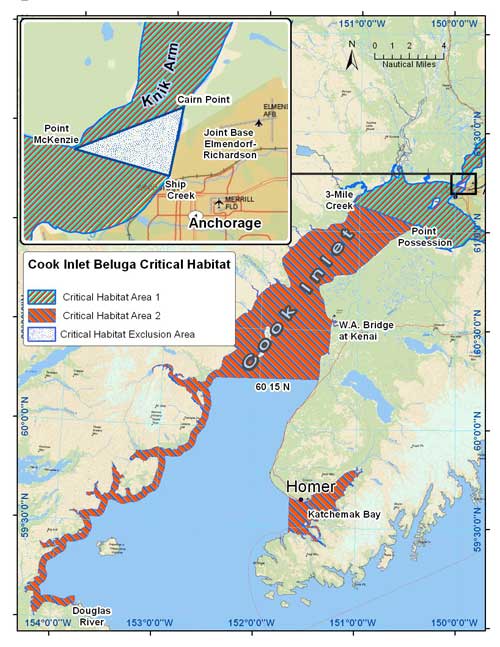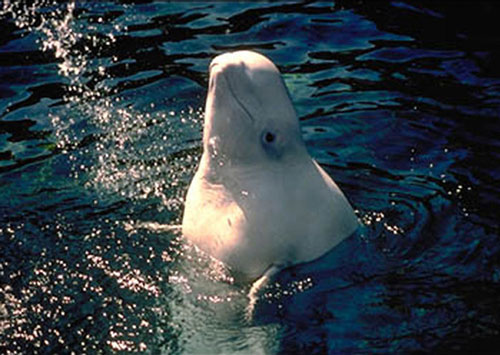
NOAA Designates Critical Habitat for Cook Inlet Beluga Whale
Murkowski Sees “Bad Math” In Cook Inlet Critical Habitat Decision
Designation harmful, uncecessary, hurts economy
April 08, 2011
Friday
(SitNews) - NOAA’s Fisheries Service today announced it is designating two areas of Alaska’s Cook Inlet as critical habitat for the endangered Cook Inlet beluga whale. Scientists estimate there are less than 350 Cook Inlet beluga whales left in the wild. This distinct population segment was listed as endangered in October 2008.
The critical habitat comprises 3,016 square miles (7,809 square kilometers) of marine and estuarine environments considered by scientists to be essential for the whales’ survival. These areas contain important biological and physical features for these cetaceans, such as feeding areas near the mouths of salmon streams. Not all of the current range of these whales was found to be critical.

A Cook Inlet beluga whale calf and its mother in upper Cook Inlet
Photo courtesy NOAA
The critical habitat designation, required under the Endangered Species Act, only affects activities that involve a federal permit, license or funding and which may affect critical habitat, such as construction and operation of oil rigs, port construction, dredging, or Environmental Protection Agency-authorized discharges into Cook Inlet.
One designated area includes the upper portions of Cook Inlet, Turnagain Arm and Knik Arm where belugas concentrate in summer months. The other area includes areas where the population congregates in the winter, which includes the middle of Cook-inlet, foraging areas along the western shore of lower Cook Inlet, and Kachemak Bay along east of Cook Inlet near the town of Homer.
NOAA’s Fisheries Service has excluded the Port of Anchorage from critical habitat because of its importance to national security, and the Eagle River Flats Range on Joint Base Elmendorf-Richardson because this area provides benefit to beluga whales under an existing Department of Defense Integrated Natural Resource Management Plan.
NOAA’s Fisheries Service based its designation on the results of more than 20 years of research, and has completed an economic analysis on the critical habitat designation. That analysis found that benefits of the designation to beluga whales exceeded the costs.
Sen. Lisa Murkowski says today’s designation of over 3,000 square miles of Cook Inlet as Critical Habitat is far costlier than the National Oceanic and Atmospheric Administration (NOAA) figures contend. NOAA announced today it is designating two areas of Alaska’s Cook Inlet as critical habitat for the endangered Cook Inlet beluga whale, while exempting the Port of Anchorage and Eagle River Flats Range.

Map courtesy NOAA
“I understand the Beluga habitat needs protection, but I have serious concerns with NOAA’s figures to justify it,” said Sen. Murkowski. The costs involved are 100 times higher than they’re estimating. Beyond their bad math, I remain extremely concerned the critical habitat designation will lead to something all too common to Alaska: more delays in permitting, construction and protracted litigation.”
Scientists estimate there are less than 350 Cook Inlet beluga whales left in the wild – a distinct population segment listed as endangered in October 2008. The critical habitat comprises 3,016 square miles (7,809 square kilometers) of marine and estuarine environments considered by scientists to be essential for the whales’ survival.
NOAA’s impact cost estimates average out to $364,000 over the next decade. But an independent economic analysis prepared for the Resource Development Council put the cost of varying economic scenarios between $39 million and $400 million per year.
The designation of more than one-third of Cook Inlet as Critical Habitat includes all of Anchorage and Mat-Su Borough’s tidal waters, extending south in Cook Inlet past the city of Kenai. The designation also includes areas across the inlet from the Kenai Peninsula and parts of Kachemak Bay.
Murkowski said, "The Port of Anchorage and Eagle River Flats Range were excluded from Critical Habitat for reasons of national security. To this Senator Murkowski commented, “I am pleased that NOAA excluded these areas under section 4 (b) (2) of the ESA recognizing their vital role in the national security of the United States.”
Alaska Governor Parnell said the critical habitat decision will harm the Cook Inlet economy. In a prepared statement Parnell said, “Today’s announcement is another example of the federal government unnecessarily locking up Alaska land from development."
Governor Parnell said, “The State filed comments on the beluga whale regarding the endangered species designation, the critical habitat designation and we filed suit to challenge the designation of belugas as endangered. Now that we have a final decision on critical habitat, we will review the decision and continue to fight these federal actions that destroy jobs and opportunities for economic development."
“No one cares about the Alaskan environment more than Alaskans," said Parnell. "Despite the passage of legislation last year and the protestations of legislators who represent and live in these communities, and evidence that the beluga whale population is recovering, the federal government has taken this action. The likely result will be less resource development, less economic development, and fewer jobs at a time when the president recently called for increased domestic energy production. Presidential statements are one thing, but again the agencies continue to lock up land and hurt our families and Alaska communities.”
The Alaska Department of Fish and Game expressed concern that vast areas of habitat were identified as critical despite their lack of important habitat features for beluga whales or documented use. “There is insufficient data to substantiate the designation of these vast areas of Cook Inlet as critical habitat for beluga whales,” said Commissioner Cora Campbell. “Many of these areas lack the essential features identified as important to beluga whales.”
Congressman Don Young (R-AK) said in a prepared statement, “While I am pleased that NOAA recognized the importance of the Port of Anchorage and the Eagle River Flats Range, the decision to list the whales as endangered will only serve to endanger Alaska and its economy. This designation comes only a few days after lease sales in the Cook Inlet were announced, and will now inevitably be used to shutdown production in that area. These designations have become purely political and an excuse to shut down production, and are no longer strictly the conservation tool they were originally meant to be."
Young said, “In recent years National Marine Fisheries Service announced the Cook Inlet Beluga Whale population to not only be stable but to have increased slightly from previous years. This designation has not been based on credible science and is yet another example of the egregious misuse of the Endangered Species Act.”
Alaska House Speaker Mike Chenault (R-Nikiski) said in a prepared statement, “This is another prime example of the federal government locking up our land and ignoring the calls for caution from the State of Alaska and the Legislature."
Chenault said, “We have continually struck back against the federal government’s lack of consideration of the state’s own data that shows the Beluga population is recovering."
“They are closing off the middle and lower Cook Inlet for federal permits next month. That means no construction, drilling or dredging. What good is exempting the Port of Anchorage if the federal government chokes Alaska’s economy to the point that cargo vessels won’t come calling? What about development of Port McKenzie? Sadly, we’ve feared this decision since they originally listed the Beluga in 2008," said Chenault.
Chenault said, “This rule sends a terribly mixed message. The President of the United States says he wants to lessen reliance on foreign oil – he’s re-opened the permitting process for offshore oil and gas – but with this habitat designation, the feds are blocking just that sort of development. The State of Alaska approved helping to pay for a jack-up rig to hit the Inlet this summer. This federal overreach could jeopardize that work. It is especially troubling for the Kenai, following on the heels of the LNG plant’s closure earlier this year. We were hoping to see the benefit of the state participation in drilling this summer. Now? It’s out the window.

Cook Inlet beluga whale
Photo courtesy NOAA
“I am, and will continue to be, indignant on this issue," said Chenault.
“The federal government ignored state data and biologists, and Alaskans and our kids will have to pay for it. That means fewer jobs, less economic multipliers of that payroll, and less energy security and stability for the entire Railbelt region," said Chenault.
Today’s announcement by the National Oceanic and Atmospheric Administration that 3,016 square miles of Cook Inlet will now be designated as critical habitat for Cook Inlet beluga whales was greeted with a mix of disappointment and relief by Rep. Charisse Millett (R-Anchorage).
“I am relieved the Port of Anchorage and the Eagle River Flats Range were excluded,” said Rep. Millett. “The remaining areas are of great concern to me because of the unknown impacts it will have on management and development of resources in the Cook Inlet area and especially the Port McKenzie area.”
The Alaska Legislature passed a resolution last year, HJR 40, sponsored by Rep. Millett. It opposed a critical habitat designation for Cook Inlet belugas. It cited clear evidence the population was rebounding and that a new harvest plan enacted in the late 1990’s paved the way for the comeback.
The fact that the beluga population is on the rebound was never mentioned in the decision announcing the critical habitat designation. It also made the questionable statement that the costs stemming from a critical habitat designation are outweighed by its benefits.
Rep. Millett said she will continue to oppose the critical habitat designation and ask the agency to reconsider its decision.
The NOAA’s Fisheries Service said they developed the final rule after an extensive public input process which included an initial 60-day comment period on the proposed rule, which was extended an additional 30 days. Four public hearings were also held. As a result of the public hearings and open comment periods, more than 135,000 individual submissions were received. The agency considered all public comments in developing the final rule, and provided responses to all significant issues raised by respondents.
This rule was published today in the Federal Register and will become effective in 30 days. The final rule, maps, status reviews, and other materials supporting this final rule can be found at http://alaskafisheries.noaa.gov/.
On the Web:
Final Rule
http://www.alaskafisheries.noaa.gov/prules/cibeluga_ch040811.pdf
Sources of News:
NOAA Fisheries in Alaska
alaskafisheries.noaa.gov
www.afsc.noaa.gov
Office of U.S. Senator Lisa Murkowski
www.murkowski.senate.gov
Office of Congressman Don Young
www.donyoung.house.gov
Office of Alaska Governor Sean Parnell
www.gov.state.ak.us
House Speaker Mike Chenault
Office of Rep. Charisse Millett
E-mail your news &
photos to editor@sitnews.us
Publish A Letter in SitNews Read Letters/Opinions
Contact the Editor
SitNews ©2011
Stories In The News
Ketchikan, Alaska
|

